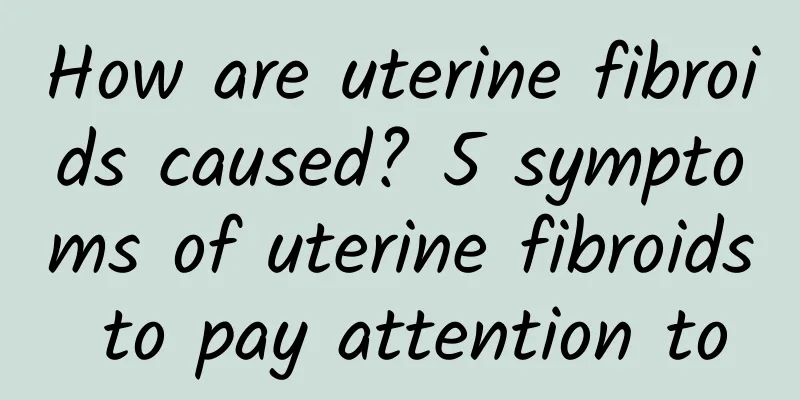|
How are uterine fibroids caused? Here are 5 symptoms of uterine fibroids to watch out for. How are uterine fibroids caused? The exact cause of uterine fibroids is still unclear. Since uterine fibroids occur during childbearing years, are rare before puberty, and shrink or disappear after menopause, it indicates that their occurrence may be related to female hormones. In addition, studies have found that genetic factors also affect the incidence of uterine fibroids. The causes of uterine fibroids include the following three categories: First, general factors.
1. Age: Uterine fibroids mostly occur in women of childbearing age, mostly in women aged 30-50, and rarely in adolescent women. Uterine fibroids shrink or disappear after menopause.
2. Obesity: Obesity can cause metabolic disorders, leading to insufficient cyclical regulation of progesterone, abnormal menstrual cycles, affecting ovulation, and increasing the risk of uterine fibroids.
3. History of pregnancy and miscarriage: Women with no history of pregnancy and childbirth are more likely to develop uterine fibroids and have an earlier age of onset than women with a history of pregnancy and childbirth, mainly because the ability to give birth increases the progesterone in women's bodies.
4. Smoking and drinking: Smoking and drinking can easily induce uterine fibroids. Studies have shown that women who smoke a pack of cigarettes a day are six times more likely to develop uterine fibroids than non-smoking women.
Second, hormone levels.
1. Low estrogen: Biochemical tests have confirmed that the conversion of estradiol to estrogen in fibroids is significantly lower than that in normal muscle tissue, and the concentration of estrogen receptors in fibroids is significantly higher than that in surrounding muscle tissue. Therefore, one of the important factors for the high sensitivity of fibroid tissue to estrogen is local estrogen.
2. Low progesterone content. Progesterone can promote mitosis and growth of fibroids. If the progesterone level in women is low, it is easy to induce uterine fibroids.
Third, genetic factors.
Cytogenetics shows that 25%-50% of uterine fibroids have cytogenetic abnormalities, such as chromosome fragment position exchange, chromosome long arm rearrangement or partial deletion. Uterine fibroids are formed by the proliferation of monoclonal smooth muscle cells, and multiple uterine fibroids are formed by different clone cells.
The symptoms of uterine fibroids are mainly irregular menstruation, lower abdominal mass, increased leucorrhea, compression, back pain, etc. If these symptoms are found, be careful to avoid worsening of the condition and affecting the treatment effect. The symptoms of uterine fibroids are as follows:
Symptoms of uterine fibroids.
One is irregular menstruation.
Increased and prolonged menstruation are the most common symptoms of uterine fibroids. They are more common in large intramural fibroids and submucosal fibroids, which enlarge the uterine cavity and the area of the endometrium, affecting uterine contraction. In addition, fibroids may squeeze the veins near the tumor, causing congestion and dilation of the endometrial venous plexus, resulting in increased and prolonged menstruation. When submucosal fibroids are accompanied by necrotic infection, irregular vaginal bleeding or bloody purulent discharge may occur. Long-term increased menstruation can lead to symptoms such as anemia, fatigue, and palpitations.
The second is a mass in the lower abdomen.
When the fibroids gradually grow larger and the uterus is more than 3 months pregnant, it can be touched from the abdomen. Huge submucosal fibroids can be prolapsed from the vagina, and the patient can prolapse from the vulva.
Third, the amount of leucorrhea increases.
Intermuscular fibroids increase the area of the uterine cavity, increase the secretion of endometrial glands, and are accompanied by pelvic congestion, resulting in increased vaginal discharge; once submucosal fibroids are infected, a large amount of purulent vaginal discharge may occur. If there is ulceration, necrosis, and bleeding, bloody or purulent vaginal discharge with a foul odor may occur.
Fourth, compression symptoms.
Myomas in the lower part of the anterior uterine wall can compress the bladder, causing frequent and urgent urination; cervical myomas can cause dysuria and urinary retention; uterine posterior wall myomas (isthmus or posterior wall) can cause symptoms such as lower abdominal swelling and constipation. Broad ligament myomas or giant cervical myomas develop laterally, embed into the pelvic cavity, compress the ureter, and block the upper urinary tract, causing ureteral dilatation and even hydronephrosis.
Five are other symptoms.
These include lower abdominal distension, back pain, and worsening menstrual symptoms. Acute lower abdominal pain occurs when the tumor changes to red color, accompanied by vomiting, fever, and local tenderness; acute abdominal pain occurs when the pedicle of the subserosal fibroid is twisted; abdominal pain occurs when the submucosal fibroid is discharged from the uterine cavity. Submucosal and intramural fibroids that cause deformation of the uterine cavity can cause infertility or miscarriage. |










